人教版(2019)选择性必修第一册Unit 3 Fascinating Parks Listening and Speaking课件(共24张PPT,内镶嵌音频)
文档属性
| 名称 | 人教版(2019)选择性必修第一册Unit 3 Fascinating Parks Listening and Speaking课件(共24张PPT,内镶嵌音频) | 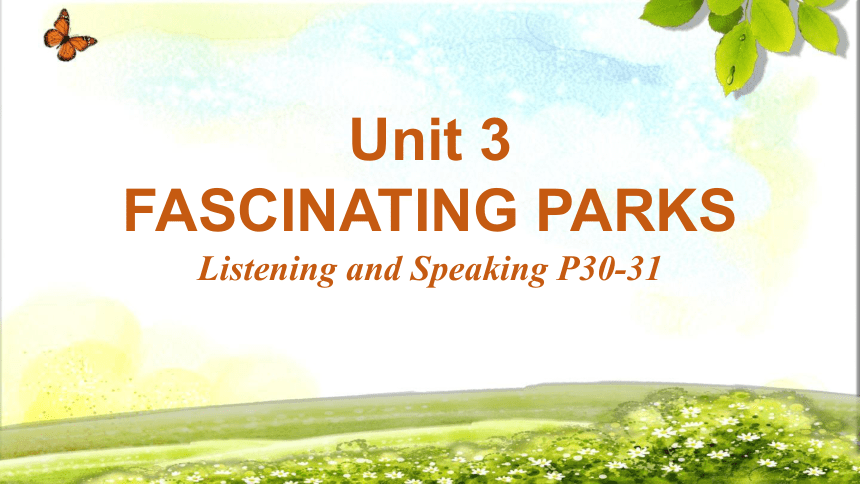 | |
| 格式 | pptx | ||
| 文件大小 | 36.8MB | ||
| 资源类型 | 教案 | ||
| 版本资源 | 人教版(2019) | ||
| 科目 | 英语 | ||
| 更新时间 | 2023-09-23 20:54:28 | ||
图片预览

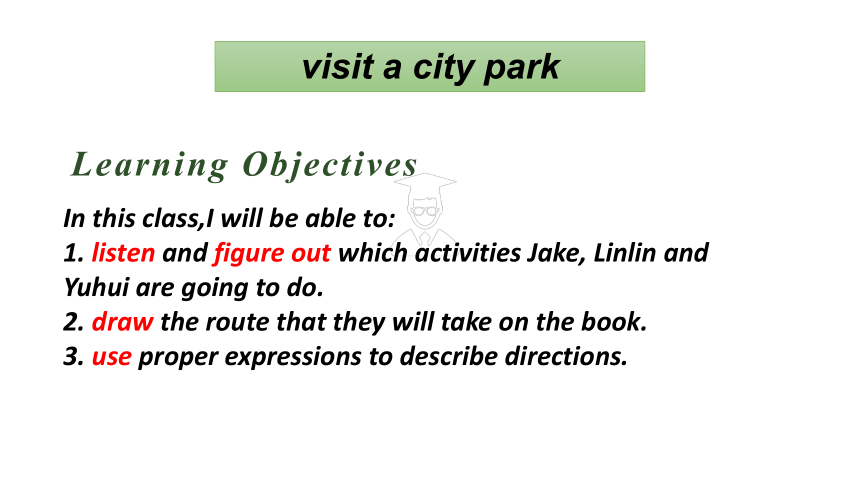
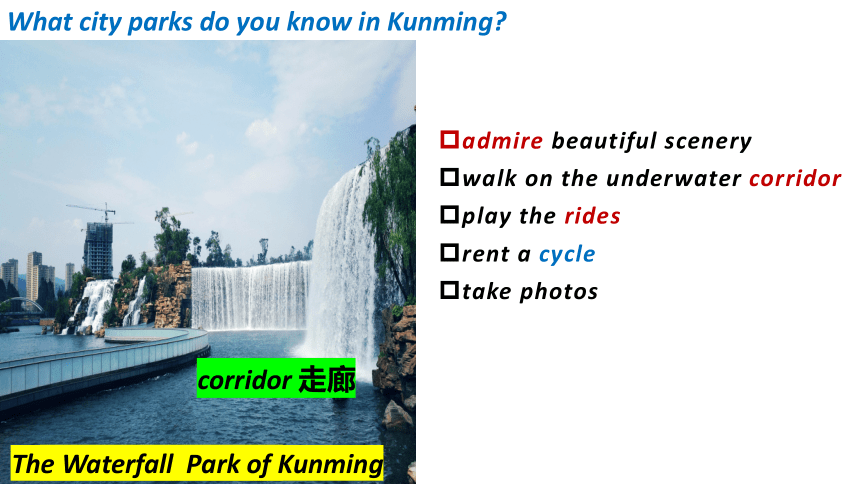
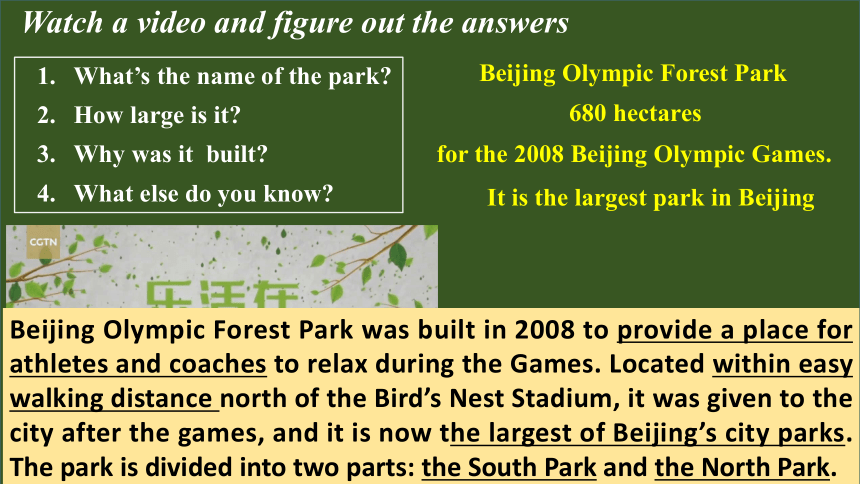
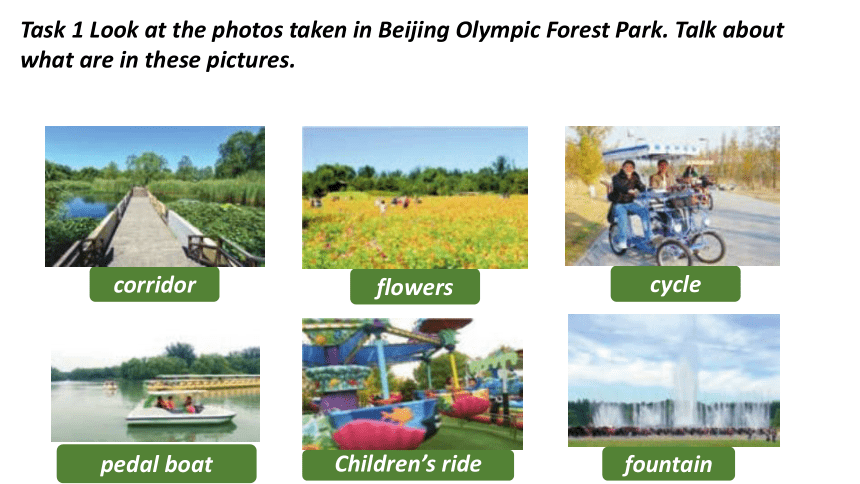
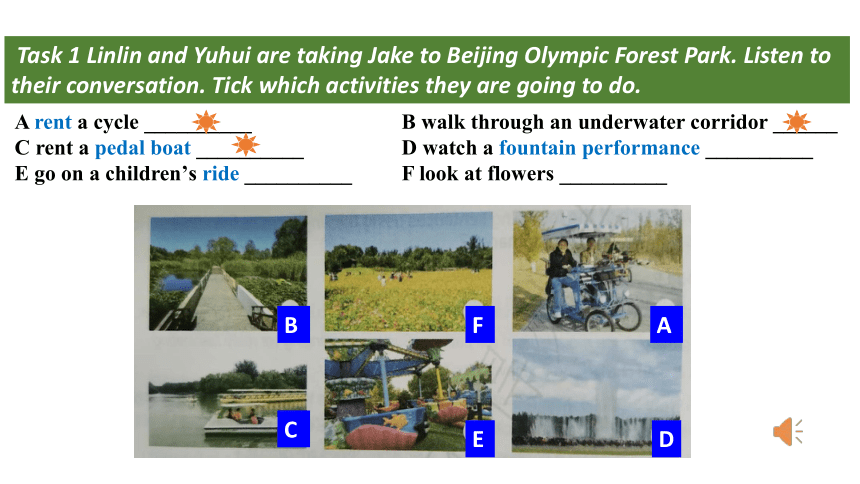
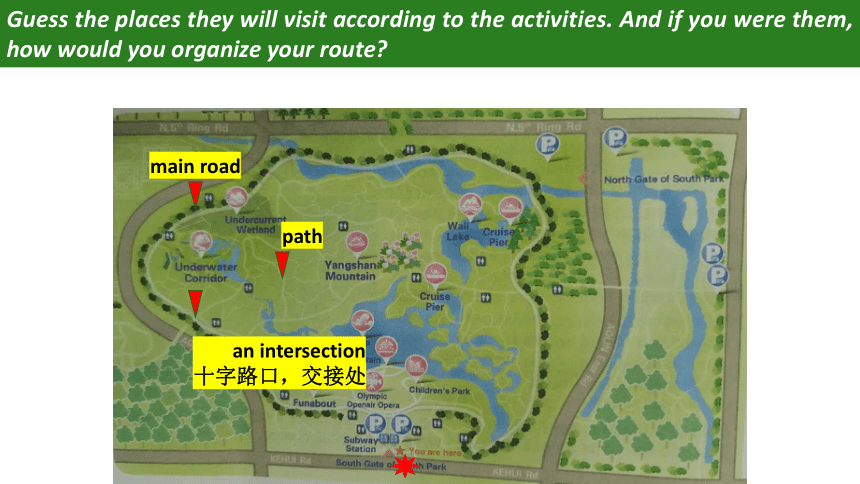
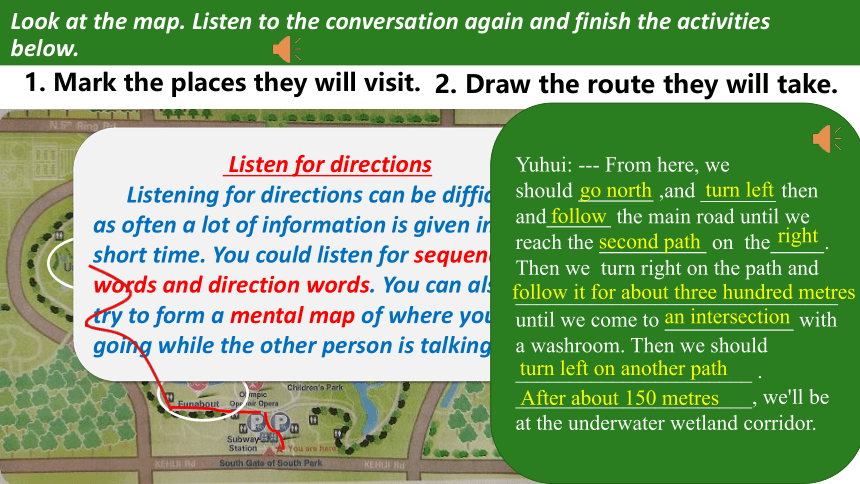
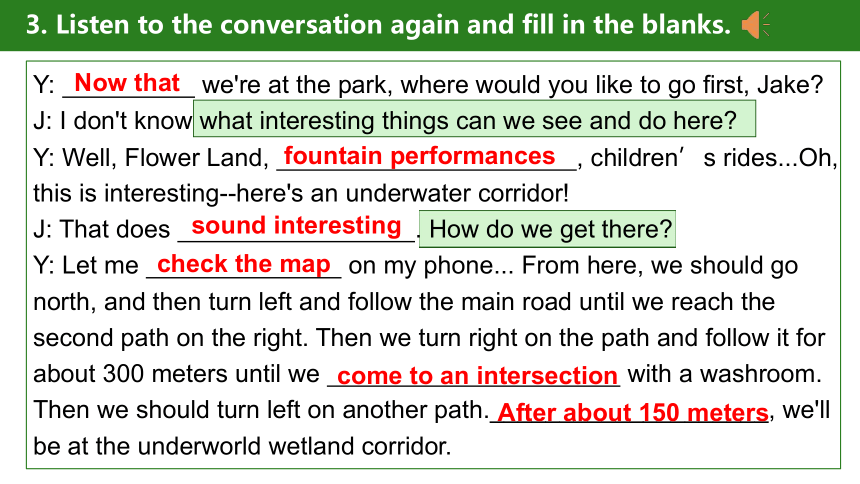
文档简介
(共24张PPT)
Unit 3
FASCINATING PARKS
Listening and Speaking P30-31
Learning Objectives
添加标题
添加标题
添加标题
In this class,I will be able to:
1. listen and figure out which activities Jake, Linlin and Yuhui are going to do.
2. draw the route that they will take on the book.
3. use proper expressions to describe directions.
visit a city park
What city parks do you know in Kunming
The Green Lake Park
The Waterfall Park of Kunming
corridor 走廊
admire beautiful scenery
walk on the underwater corridor
play the rides
rent a cycle
take photos
Watch a video and figure out the answers
What’s the name of the park
How large is it
Why was it built
What else do you know
680 hectares
Beijing Olympic Forest Park
for the 2008 Beijing Olympic Games.
It is the largest park in Beijing
Beijing Olympic Forest Park was built in 2008 to provide a place for athletes and coaches to relax during the Games. Located within easy walking distance north of the Bird’s Nest Stadium, it was given to the city after the games, and it is now the largest of Beijing’s city parks. The park is divided into two parts: the South Park and the North Park.
Task 1 Look at the photos taken in Beijing Olympic Forest Park. Talk about what are in these pictures.
corridor
flowers
cycle
pedal boat
Children’s ride
fountain
Look at the photos taken in Beijing Olympic Forest Park. Match them with the activities below. Write the correct letter in each circle.
A rent a cycle __________ B walk through an underwater corridor ______
C rent a pedal boat __________ D watch a fountain performance __________
E go on a children’s ride __________ F look at flowers __________
B
A
C
D
F
E
Task 1 Linlin and Yuhui are taking Jake to Beijing Olympic Forest Park. Listen to their conversation. Tick which activities they are going to do.
Guess the places they will visit according to the activities. And if you were them, how would you organize your route
an intersection
十字路口,交接处
main road
path
Look at the map. Listen to the conversation again and finish the activities below.
1. Mark the places they will visit.
2nd path
intersection
Listen for directions
Listening for directions can be difficult,
as often a lot of information is given in a
short time. You could listen for sequence
words and direction words. You can also
try to form a mental map of where you are
going while the other person is talking.
Yuhui: --- From here, we should ,and _______ then and the main road until we reach the on the . Then we turn right on the path and ______________________________until we come to with a washroom. Then we should ______________________ .
______________________, we'll be at the underwater wetland corridor.
go north
turn left
follow
second path
right
an intersection
turn left on another path
follow it for about three hundred metres
After about 150 metres
2. Draw the route they will take.
3. Listen to the conversation again and fill in the blanks.
Y: we're at the park, where would you like to go first, Jake
J: I don't know what interesting things can we see and do here
Y: Well, Flower Land, , children’s rides...Oh, this is interesting--here's an underwater corridor!
J: That does . How do we get there
Y: Let me on my phone... From here, we should go north, and then turn left and follow the main road until we reach the second path on the right. Then we turn right on the path and follow it for about 300 meters until we with a washroom. Then we should turn left on another path.____________________, we'll be at the underworld wetland corridor.
Now that
fountain performances
sound interesting
check the map
come to an intersection
After about 150 meters
L: Oh, that sounds a bit far.
J: Well, maybe we can to go there.
Y: No, we can't. There are four-wheel cycles, but there are only allowed on certain . Let me check the map again... Oh, we're actually very near the cycle rental place now. We could go there first, if you like.
L: Yes, OK, it would be fun! Hopefully we can the underworld wetland corridor and I'd also like to on Wali Lake afterwards.
J: Sounds like we've got a lot of things to do.
Y: Yes, so we'd better .
rent bikes
fixed routes
get close to
take pedal boat
get started
Warming up (p77)
The Polynesian Cultural Center, located near Bay on the north shore of Oahu, Hawaii(夏威夷州瓦胡岛北岸莱伊附近), about 65 kilometers from Honolulu(檀香山), is a large national culture museum.Founded in 1963 by The Mormon Brigham Young University(摩门教杨百翰大学) to preserve Polynesian history and cultural traditions.
/ p l ni n/波利尼西亚的
Listening
David Evans and Li Yang are visiting the Polynesian Cultural Centre in Hawaii. Listen to their conversation and answer the following questions.
1. How many different Polynesian cultures are represented at the park
2. What are canoes, and why are they important to the Polynesians
3. What did the Samoans use to make fire
4. Where do the Maori put the tattoos
5. Why does David tell Li Yang not to worry about getting a tattoo
/k nu z/独木舟
/s m n/ 萨摩亚人
/ ma ri/ 毛利人的
/t tu / 纹身
Listening
1. How many different Polynesian cultures are represented at the park
2. What are canoes, and why are they important to the Polynesians
3. What did the Samoans use to make fire
4. Where do the Maori put the tattoos
5. Why does David tell Li Yang not to worry about getting a tattoo
Six.
Canoes are small boats that the Polynesians used to travel thousands of kilometres.
Using Sticks.
On their faces.
It’s not a real tattoo—it can be washed off.
Listening
Listen to the conversation again and finish the following tasks.
1. locate the places they are going.
2. draw the route they will take.
3. fill in the blanks on yur handout
Listening materials
David Evans: Here's a park map. Where should we start
Li Yang: I don’t get it. I thought this park was about Polynesian culture, but the park map shows six different cultures.
David Evans: Well, though the people of Polynesia are all related, Polynesia is made up of several different cultures spread out across the South Pacific.
Li Yang: Oh. I see. So what can we do here
David Evans: For a start, we can take a canoe tour of the park.
Li Yang: Canoe What's that
David Evans: It's a small boat. Traditional canoes are carved from a single tree, so they are often quite narrow. The Polynesians used canoes to travel thousands of kilometers.
Li Yang: That’s interesting. Where do we go to find them
David Evans: Well, to get to the canoes, we need to go straight. Then after we cross the bridge, we turn left. They should be quite near there … Then after the canoes, we can learn how to make fire the traditional way, using sticks.
Li Yang: Where can we do that
David Evans: The guide says we should go to the Samoan Village. That shouldn't be very hard to find. From the canoes, we just go straight, and then take the bridge on the right. It should be a short walk away on the left. Oh, and next to the Samoan Village is the Aotearoan Village. We can get Maori tattoos there.
Li Yang: Maori tattoos
David Evans: Yes. The Maori like to tattoo their faces with interesting designs.
Li Yang: But I don't want to tattoo my face.
David Evans: Don’t worry! It's not a real tattoo. We can wash it off later.
Li Yang: Cool! But first, the canoe tour.
David Evans: Yes! I can’t wait. Let's go.
Direction words
2nd
3nd
go up/down/straight/along/
north/south/east/west
turn left
turn right
go cross/across
turn around
turn left at the second turning
take the 3rd turning on your right
Intersection
十字路口
Direction words
The school is on your left.
The school is next to the hospital.
The school is opposite the hospital
The school is between the hospital and the supermarket
SCHOOL
go past the school
Go straight on, until you get to the school
SCHOOL
SCHOOL
The school is on your right.
SCHOOL
SCHOOL
HOSPITAL
SCHOOL
HOSPITAL
SCHOOL
HOSPITAL
SUPER MARKET
Work in pairs. Role-play a conversation. Take turns giving directions to different places in the our school. Use the words and phrases below to help you.
Asking for and giving directions
Excuse/Pardon me.
How do I get to …
Is … nearby
Is … far from …
It's about … metres north of…
Walk/Go along the river/path…
When you see the …, you are
close to…
Go straight ahead (until you
come to…).
Do you happen to know
where … is
How far is …
Is … close to …
It's on the north/south/
east/west side of the park.
Go through …
Follow the (main) path
to …
It's … metres from here.
11
Pair work: It is the first day for senior 1 students and they are not familiar about our school. If you are a volunteer, try to give directions to them.
11
dining hall
dormitory
library
teaching building
A: Excuse me.
B: Yes, how can I help you
A: I hear that this park has a very nice flower meadow. I was wondering if you could tell me how to find it
B: Oh, you mean Flower Land It's in the northwest corner of the North Park.
A: It sounds pretty far from here.
B: Yes, it is. It's about two-and-a-half kilometres from here on foot. But it's a lovely walk if you have the time.
A: But it's getting late. I was really hoping to see it while the sun was still shining.
B: True. Here's what you can do. You can take the underground. The Forest Park South Gate underground station is right over there. Go north one stop to the Lincuiqiao underground station. Walk north about eight hundred metres, and you'll see the park and walk about another four hundred metres. You'll see a path leading to Flower Land on your right. It's just a short distance away from there.
A: It still seems like quite a trip. Is it really worth it
B: Oh, yes. The sunflowers are in full bloom right now.
Sample Dialogue
11
A: Well, I'll have to think about it. By the way, what is this wetland underwater corridor that everyone is talking about
B: Oh, it's really neat. The South Park has this huge wetland area in the northwest corner. And there's a path that goes through the water. It has glass on both sides so that you don't get wet. You walk down into the water, and get a chance to see the plants and animals through the glass walls.
A: Is it far
B: A little. It's about a kilometre away. Go north from here, and then take the first left. Continue until the road comes to a T, and then turn right. Follow that path north for about three hundred metres until you come to an intersection. Turn right. After about 150 metres, you'll be at the south end of the wetland. There is a path there which goes north. Take it and it will lead you to the underwater corridor. You can't miss it.
A: Thank you so much!
B: You're welcome.
11
Thank you for your listening!
Unit 3
FASCINATING PARKS
Listening and Speaking P30-31
Learning Objectives
添加标题
添加标题
添加标题
In this class,I will be able to:
1. listen and figure out which activities Jake, Linlin and Yuhui are going to do.
2. draw the route that they will take on the book.
3. use proper expressions to describe directions.
visit a city park
What city parks do you know in Kunming
The Green Lake Park
The Waterfall Park of Kunming
corridor 走廊
admire beautiful scenery
walk on the underwater corridor
play the rides
rent a cycle
take photos
Watch a video and figure out the answers
What’s the name of the park
How large is it
Why was it built
What else do you know
680 hectares
Beijing Olympic Forest Park
for the 2008 Beijing Olympic Games.
It is the largest park in Beijing
Beijing Olympic Forest Park was built in 2008 to provide a place for athletes and coaches to relax during the Games. Located within easy walking distance north of the Bird’s Nest Stadium, it was given to the city after the games, and it is now the largest of Beijing’s city parks. The park is divided into two parts: the South Park and the North Park.
Task 1 Look at the photos taken in Beijing Olympic Forest Park. Talk about what are in these pictures.
corridor
flowers
cycle
pedal boat
Children’s ride
fountain
Look at the photos taken in Beijing Olympic Forest Park. Match them with the activities below. Write the correct letter in each circle.
A rent a cycle __________ B walk through an underwater corridor ______
C rent a pedal boat __________ D watch a fountain performance __________
E go on a children’s ride __________ F look at flowers __________
B
A
C
D
F
E
Task 1 Linlin and Yuhui are taking Jake to Beijing Olympic Forest Park. Listen to their conversation. Tick which activities they are going to do.
Guess the places they will visit according to the activities. And if you were them, how would you organize your route
an intersection
十字路口,交接处
main road
path
Look at the map. Listen to the conversation again and finish the activities below.
1. Mark the places they will visit.
2nd path
intersection
Listen for directions
Listening for directions can be difficult,
as often a lot of information is given in a
short time. You could listen for sequence
words and direction words. You can also
try to form a mental map of where you are
going while the other person is talking.
Yuhui: --- From here, we should ,and _______ then and the main road until we reach the on the . Then we turn right on the path and ______________________________until we come to with a washroom. Then we should ______________________ .
______________________, we'll be at the underwater wetland corridor.
go north
turn left
follow
second path
right
an intersection
turn left on another path
follow it for about three hundred metres
After about 150 metres
2. Draw the route they will take.
3. Listen to the conversation again and fill in the blanks.
Y: we're at the park, where would you like to go first, Jake
J: I don't know what interesting things can we see and do here
Y: Well, Flower Land, , children’s rides...Oh, this is interesting--here's an underwater corridor!
J: That does . How do we get there
Y: Let me on my phone... From here, we should go north, and then turn left and follow the main road until we reach the second path on the right. Then we turn right on the path and follow it for about 300 meters until we with a washroom. Then we should turn left on another path.____________________, we'll be at the underworld wetland corridor.
Now that
fountain performances
sound interesting
check the map
come to an intersection
After about 150 meters
L: Oh, that sounds a bit far.
J: Well, maybe we can to go there.
Y: No, we can't. There are four-wheel cycles, but there are only allowed on certain . Let me check the map again... Oh, we're actually very near the cycle rental place now. We could go there first, if you like.
L: Yes, OK, it would be fun! Hopefully we can the underworld wetland corridor and I'd also like to on Wali Lake afterwards.
J: Sounds like we've got a lot of things to do.
Y: Yes, so we'd better .
rent bikes
fixed routes
get close to
take pedal boat
get started
Warming up (p77)
The Polynesian Cultural Center, located near Bay on the north shore of Oahu, Hawaii(夏威夷州瓦胡岛北岸莱伊附近), about 65 kilometers from Honolulu(檀香山), is a large national culture museum.Founded in 1963 by The Mormon Brigham Young University(摩门教杨百翰大学) to preserve Polynesian history and cultural traditions.
/ p l ni n/波利尼西亚的
Listening
David Evans and Li Yang are visiting the Polynesian Cultural Centre in Hawaii. Listen to their conversation and answer the following questions.
1. How many different Polynesian cultures are represented at the park
2. What are canoes, and why are they important to the Polynesians
3. What did the Samoans use to make fire
4. Where do the Maori put the tattoos
5. Why does David tell Li Yang not to worry about getting a tattoo
/k nu z/独木舟
/s m n/ 萨摩亚人
/ ma ri/ 毛利人的
/t tu / 纹身
Listening
1. How many different Polynesian cultures are represented at the park
2. What are canoes, and why are they important to the Polynesians
3. What did the Samoans use to make fire
4. Where do the Maori put the tattoos
5. Why does David tell Li Yang not to worry about getting a tattoo
Six.
Canoes are small boats that the Polynesians used to travel thousands of kilometres.
Using Sticks.
On their faces.
It’s not a real tattoo—it can be washed off.
Listening
Listen to the conversation again and finish the following tasks.
1. locate the places they are going.
2. draw the route they will take.
3. fill in the blanks on yur handout
Listening materials
David Evans: Here's a park map. Where should we start
Li Yang: I don’t get it. I thought this park was about Polynesian culture, but the park map shows six different cultures.
David Evans: Well, though the people of Polynesia are all related, Polynesia is made up of several different cultures spread out across the South Pacific.
Li Yang: Oh. I see. So what can we do here
David Evans: For a start, we can take a canoe tour of the park.
Li Yang: Canoe What's that
David Evans: It's a small boat. Traditional canoes are carved from a single tree, so they are often quite narrow. The Polynesians used canoes to travel thousands of kilometers.
Li Yang: That’s interesting. Where do we go to find them
David Evans: Well, to get to the canoes, we need to go straight. Then after we cross the bridge, we turn left. They should be quite near there … Then after the canoes, we can learn how to make fire the traditional way, using sticks.
Li Yang: Where can we do that
David Evans: The guide says we should go to the Samoan Village. That shouldn't be very hard to find. From the canoes, we just go straight, and then take the bridge on the right. It should be a short walk away on the left. Oh, and next to the Samoan Village is the Aotearoan Village. We can get Maori tattoos there.
Li Yang: Maori tattoos
David Evans: Yes. The Maori like to tattoo their faces with interesting designs.
Li Yang: But I don't want to tattoo my face.
David Evans: Don’t worry! It's not a real tattoo. We can wash it off later.
Li Yang: Cool! But first, the canoe tour.
David Evans: Yes! I can’t wait. Let's go.
Direction words
2nd
3nd
go up/down/straight/along/
north/south/east/west
turn left
turn right
go cross/across
turn around
turn left at the second turning
take the 3rd turning on your right
Intersection
十字路口
Direction words
The school is on your left.
The school is next to the hospital.
The school is opposite the hospital
The school is between the hospital and the supermarket
SCHOOL
go past the school
Go straight on, until you get to the school
SCHOOL
SCHOOL
The school is on your right.
SCHOOL
SCHOOL
HOSPITAL
SCHOOL
HOSPITAL
SCHOOL
HOSPITAL
SUPER MARKET
Work in pairs. Role-play a conversation. Take turns giving directions to different places in the our school. Use the words and phrases below to help you.
Asking for and giving directions
Excuse/Pardon me.
How do I get to …
Is … nearby
Is … far from …
It's about … metres north of…
Walk/Go along the river/path…
When you see the …, you are
close to…
Go straight ahead (until you
come to…).
Do you happen to know
where … is
How far is …
Is … close to …
It's on the north/south/
east/west side of the park.
Go through …
Follow the (main) path
to …
It's … metres from here.
11
Pair work: It is the first day for senior 1 students and they are not familiar about our school. If you are a volunteer, try to give directions to them.
11
dining hall
dormitory
library
teaching building
A: Excuse me.
B: Yes, how can I help you
A: I hear that this park has a very nice flower meadow. I was wondering if you could tell me how to find it
B: Oh, you mean Flower Land It's in the northwest corner of the North Park.
A: It sounds pretty far from here.
B: Yes, it is. It's about two-and-a-half kilometres from here on foot. But it's a lovely walk if you have the time.
A: But it's getting late. I was really hoping to see it while the sun was still shining.
B: True. Here's what you can do. You can take the underground. The Forest Park South Gate underground station is right over there. Go north one stop to the Lincuiqiao underground station. Walk north about eight hundred metres, and you'll see the park and walk about another four hundred metres. You'll see a path leading to Flower Land on your right. It's just a short distance away from there.
A: It still seems like quite a trip. Is it really worth it
B: Oh, yes. The sunflowers are in full bloom right now.
Sample Dialogue
11
A: Well, I'll have to think about it. By the way, what is this wetland underwater corridor that everyone is talking about
B: Oh, it's really neat. The South Park has this huge wetland area in the northwest corner. And there's a path that goes through the water. It has glass on both sides so that you don't get wet. You walk down into the water, and get a chance to see the plants and animals through the glass walls.
A: Is it far
B: A little. It's about a kilometre away. Go north from here, and then take the first left. Continue until the road comes to a T, and then turn right. Follow that path north for about three hundred metres until you come to an intersection. Turn right. After about 150 metres, you'll be at the south end of the wetland. There is a path there which goes north. Take it and it will lead you to the underwater corridor. You can't miss it.
A: Thank you so much!
B: You're welcome.
11
Thank you for your listening!
